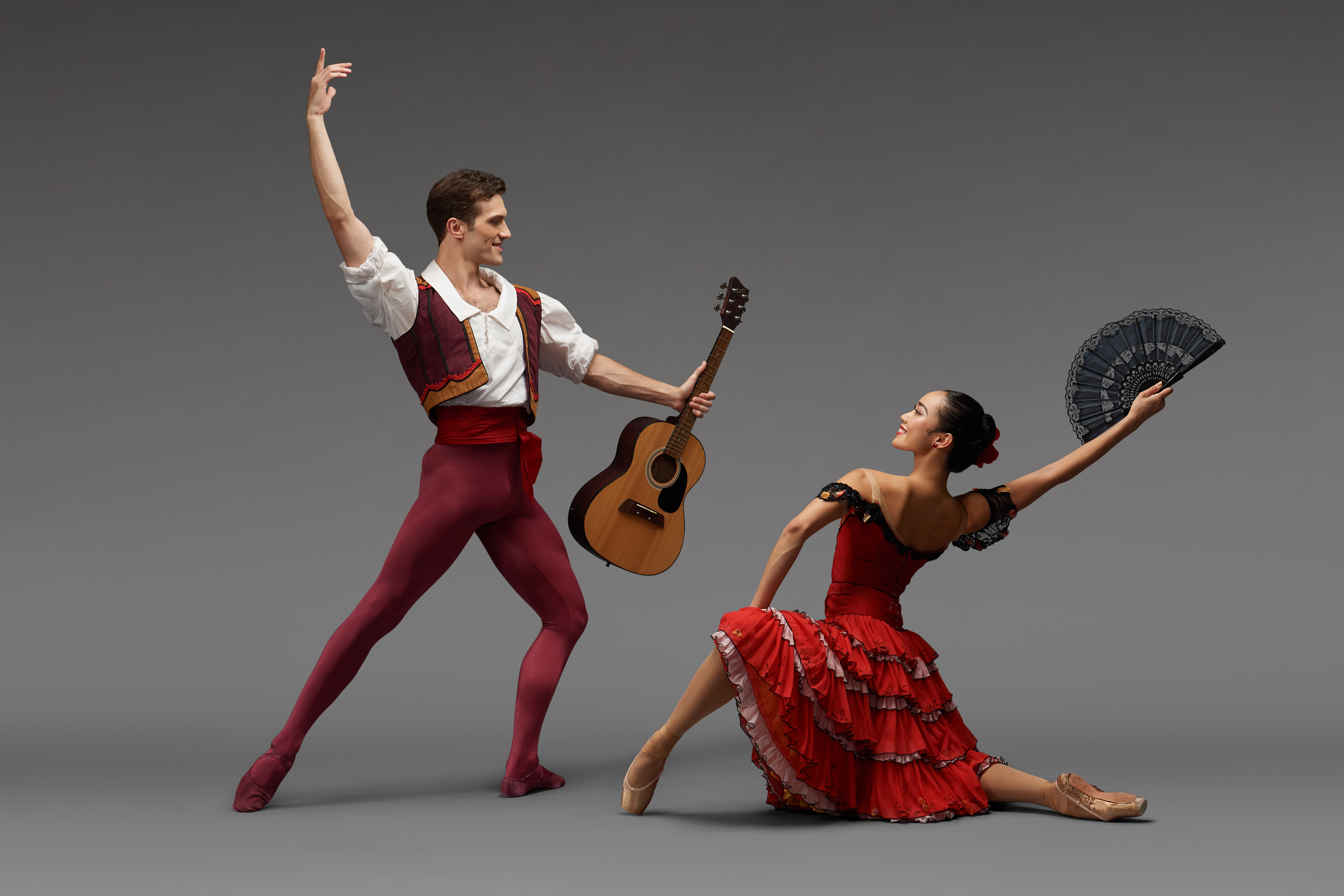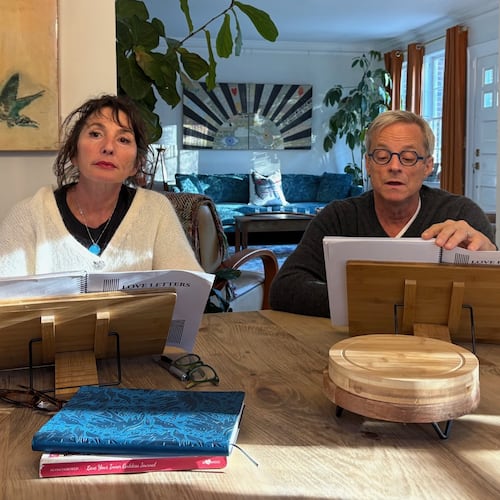This story was originally published by ArtsATL.
“‘Don Quixote’ is stylistically one of the richest classical ballets,” says Atlanta Ballet’s Artistic Director Gennadi Nedvigin. “Through the characters, it weaves together so many different traditions.” The company will perform choreographer Yuri Possokhov’s version of the rollicking, full-length ballet March 17-19 at Cobb Energy Performing Arts Centre.
The ballet tells the story of two young lovers — Kitri, the innkeeper’s daughter, and Basilio, the town barber — alongside that of the title character and his reluctant squire. It also thrills with athletic and technically challenging solos and variations. “Kitri’s entrance in the first act has so much color; it’s a bravura variation,” says Nedvigin, “and Basilio’s tavern variation, which in this production happens in the first act, opens up the classical vocabulary and gives the male principal room to move like a toreador.”
Credit: Kim Kenney
Credit: Kim Kenney
“Don Quixote’s” status as a classic means that many dancers, regardless of where they trained, learn at least some of the choreography in variations or adagio classes. But for many in the cast, which includes the main company and all the members of Atlanta Ballet 2, this will be their first time performing the full work. Several of the soloists and principalswill be debuting in new roles. Patric Palkens, for example, who joined the company this season from Boston Ballet, is taking on the role of Basilio for the first time, having performed in the corps of an Orlando Ballet production 11 years ago. He’ll dance opposite Airi Igarashi as Kitri on Friday evening and Sunday afternoon.
“Growing up, everyone wanted to figure out, probably before we should have, how to do the double saut de basque en dedans [a challenging rotating leap] from Basilio’s solo in the grand pas de deux,” Palkens said of his own experience. “We learned most of the male variations from ‘Don Q’ early on. The video [we saw] of male dancers we knew, doing those variations really well, got stuck in our brains.” Palkens said his desire to perform roles like Basilio in “Don Quixote” motivated his pursuit of a career in ballet and even informed his decision to move from Boston to Atlanta.
Credit: Kim Kenney
Credit: Kim Kenney
Atlanta Ballet recently invited ArtsATL into the enormous light-filled rehearsal studio at the Michael C. Carlos Dance Centre for a preview of its upcoming production. A peek at some of the stage props in the studio and the exquisitely ornamented doublets and tutus being refreshed in the costume shop hinted at elaborate staging to match the gorgeous dancing shaping up during rehearsal.
The first thing to draw the eye in the studio was the comfortably appointed bed off to the side at downstage left. As everyone was moving into place to begin a run-through of Act II, two men approached it wearing a cleverly articulated horse costume that hid everything but their legs. Dylan Clinard — wearing sweats and a large floppy hat and carrying a plastic ham — sauntered over to join them. He portrays Sancho Panza, Don Quixote’s sidekick.
The company had just begun rehearsing the full ensemble together. Up until that point, the corps, principals and soloists had been learning and practicing separately. While the main named character roles often steal the show, the corps in “Don Quixote” provides much of the context and motivation. Palkens says this gives an extra layer of meaning to the steps he and the other leads perform. In final notes for the company before breaking for lunch, Nedvigin told the corps dancers: “The principals and soloists are looking for you while they are dancing. You need to be there for them and engage with each other.”
As ArtsATL’s Kathleen Wessel observed when the company last staged “Don Quixote” in 2018, the ballet is among the handful of late 19th century works, including “Swan Lake” and “Sleeping Beauty,” that represent the grand tradition of classical story ballets. The heart of the action in “Swan Lake” and “Sleeping Beauty,” though, takes place in castles and forests, which even into the 20th century were often the exclusive preserve of landed nobility. In contrast, “Don Quixote,” created by Marius Petipa for the Russian stage in 1869 and substantially revised by Alexander Gorsky in 1900, unfolds in the village square and tavern, and ranges across the countryside.
The ballet draws its subject matter not from anonymous folk tales, but from Miguel de Cervantes’ precocious literary masterpiece, published in two parts in 1605 and 1615 and often acknowledged as the first novel. The narrative of “Don Quixote” the ballet places the villagers and petty gentry front and center. In many other classical ballets, they merely provide the local color or divertissement. Hence Clinard as Sancho Panza with his ham, Quixote with his makeshift armor and improvised lance, and the large cast of characters that carouse, brawl, prank and, of course, dance their way through Possokhov’s update of this iconic ballet.
In addition to the lavish props and costumes, stage design in this production features projections inspired by Gustave Doré's famous 19th century illustrations of the novel, and the Ludwig Minkus score this weekend will be in the capable hands and instruments of the Atlanta Ballet Orchestra.
::
Robin Wharton studied dance at the School of American Ballet and the Pacific Northwest Ballet School. As an undergraduate at Tulane University in New Orleans, she was a member of the Newcomb Dance Company. In addition to a Bachelor of Arts in English from Tulane, Robin holds a law degree and a Ph.D. in English, both from the University of Georgia.
DANCE PREVIEW
Atlanta Ballet: “Don Quixote”
March 17-19. $25-$142. Cobb Energy Performing Arts Centre, 2800 Cobb Galleria Parkway, Atlanta. 404-892-3303, atlantaballet.com.
Credit: ArtsATL
Credit: ArtsATL
MEET OUR PARTNER
ArtsATL (www.artsatl.org), is a nonprofit organization that plays a critical role in educating and informing audiences about metro Atlanta’s arts and culture. Founded in 2009, ArtsATL’s goal is to help build a sustainable arts community contributing to the economic and cultural health of the city.
If you have any questions about this partnership or others, please contact Senior Manager of Partnerships Nicole Williams at nicole.williams@ajc.com.
About the Author
Keep Reading
The Latest
Featured





